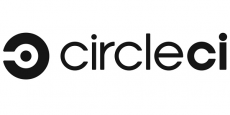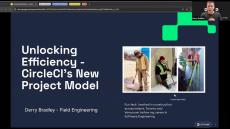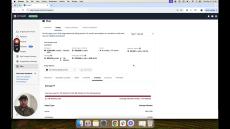|
By Jacob Schmitt
So much of our modern software runs on containers. Containerized applications offer great flexibility for developers, but they also come with security risks. Container security is a holistic approach to managing risk in containerized environments. Securing containers requires a broad approach incorporating different tools and policies that enforce security in the software supply chain, infrastructure, container runtime environments, and other potential container attack surfaces.
|
By Jacob Schmitt
Behavior-Driven Development (BDD) is a software development methodology in which applications are built to match the behaviors a user would expect from the software. An evolution of Test-Driven Development (TDD), BDD gathers user stories about how users expect applications to behave, then creates software tests to validate that their applications match this behavior. The BDD methodology utilizes specific language and naming conventions.
|
By Jacob Schmitt
Unit testing is a software testing methodology that tests the behavior of individual functional units of code. Through unit testing, developers can verify that their code performs as intended. Providing an opportunity to catch bugs, validate the implementation of logic, and assess the quality of the code, unit testing enhances the quality of applications and preemptively identifies problems before they become major issues.
|
By Jacob Schmitt
The Software Development Lifecycle (SDLC) is a methodology that provides a structured process for developing high-quality software in a timely and cost-effective manner. The SDLC outlines software development as a series of tasks, creating a management framework focused on efficiency and quality. Software development is a tightly interwoven process that balances costs, deadlines, and capabilities.
|
By Jacob Schmitt
The core concept of developer experience (or DevEx) is simple: happy developers are more effective developers. Great developer experiences create opportunities for success, while poor DevEx leads to frustration and delays. Though the concept is easy to grasp, real-world developer experiences depend on many complex factors.
|
By Derry Bradley
In a traditional CI/CD pipeline, the instructions for how your pipeline should run are stored in the same repository as your application code, creating a rigid 1:1 relationship between your pipeline and project code. This approach has benefits, like keeping pipeline logic close to the code it supports, but it also introduces challenges, especially for organizations managing multiple repositories or microservices.
|
By Jim Rose
For engineering leaders and technology decision-makers, CI/CD metrics have always been more than just operational measurements – they’re direct indicators of developer experience and team productivity. Every failed build, slow pipeline, or delayed deployment directly impacts your developers’ ability to deliver value.
|
By Tadashi Nemoto
With the increasing adoption of Kubernetes in recent years, there are various means and tools for achieving continuous delivery to Kubernetes. While it is possible to create a consistent CI/CD pipeline up to deploying to Kubernetes using CI/CD tools like CircleCI, there has been a rise in cases combining dedicated CD tools like FluxCD and ArgoCD to achieve this as well. A common aspect among these CD-dedicated tools is their adoption of GitOps.
|
By Vivek Maskara
LlamaIndex is a framework for building context-augmented large language model (LLM) applications. It enables you to augment the model with domain-specific data to customize it and improve its responses to your use case. You can use this framework to build a question-answering chat bot, a document understanding and extraction application, or an autonomous agent. The framework provides tools to ingest data, process it, and implement query workflows that combine data access with LLM prompts.
|
By Waweru Mwaura
As codebases mature, they grow in complexity. As time goes on, higher complexity increases the cost of changing and scaling a system. Scalability is an essential feature of enterprise software. End-to-end integration testing is not a very scalable process, especially when you are dealing with multiple systems.
|
By CircleCI
This hands-on webinar shows you CircleCI's new project model, designed to give you maximum flexibility on how you organize your CI/CD. In this session, we will cover a new set of capabilities.
|
By CircleCI
CircleCI Technical Success Manager, Nico, guides you through using the CircleCI Support Center to efficiently resolve issues and access support. Learn how to navigate the Support Center, use the knowledge base, and utilize the AI widget for quick answers. Nico also explains how to submit a support ticket, ensuring it reaches the right team—whether for build issues, billing, or advisory services.
|
By CircleCI
In this video, CircleCI’s Technical Success Manager, Adrian, walks you through simple yet effective strategies for managing storage costs on CircleCI. Learn how to adjust retention periods for artifacts, caches, and workspaces to significantly reduce credit usage each month. Adrian covers how to review storage usage in the CircleCI UI, identify high-storage components, and set optimal retention durations. Ideal for teams looking to lower overhead costs on CircleCI while maintaining efficient builds. Start saving credits and optimizing your storage strategy today!
|
By CircleCI
Learn how to maximize efficiency and minimize costs with CircleCI by right-sizing your resources. In this video, CircleCI's Technical Success Manager, Nic, demonstrates how to adjust resource allocations for jobs based on utilization trends, helping you optimize CPU and RAM usage, reduce credit consumption, and prevent resource overuse issues like out-of-memory errors. Discover tips on monitoring resource usage, leveraging the insights tab, and using CircleCI’s Usage API for automated tracking. Perfect for developers looking to streamline their CI/CD workflows and get the most out of CircleCI’s platform!
|
By CircleCI
In this episode of The Confident Commit, Rob sits down with Christine Yen, CEO of Honeycomb, to delve into the evolving role of observability in modern software development. They discuss how observability goes beyond traditional metrics and monitoring, and allows developers to be better prepared for the unknown and embrace the complexities of distributed systems. Christine shares insights on how observability not only boosts developer confidence but also enhances productivity by reducing toil and enabling teams to focus on delivering value for customers.
|
By CircleCI
In this episode, Rob sits down with Ken Rose, CTO of OpsLevel, to delve into the evolving landscape of platform teams and the pressing challenges they face. Together, they explore OpsLevel's mission to tackle the mounting complexities encountered by modern organizations.
|
By CircleCI
Discover how digital transformation can revolutionize your business processes, culture, and customer experiences. Learn about the key benefits, including enhanced customer satisfaction, operational efficiency, and increased competitiveness. See how automation and CI/CD pipelines streamline operations and drive innovation.
|
By CircleCI
Discover how CircleCI can streamline your CI/CD workflow in this 2-minute demo. Learn how to set up, configure, and deploy with ease. To learn more about the CircleCI offerings, visit.
|
By CircleCI
Are you looking to enhance your version control skills and streamline your CI/CD pipeline? Listen to our on demand webinar to learn.
|
By CircleCI
Join the CircleCI product team for an in-depth look at just-launched and upcoming features. This webinar starts with a quick overview of what we're building and why. Then we cover new features and upcoming changes across CI, CD and AI & LLMOps. We cover everything from config optimization recommendations to release tracking to testing config changes locally with the VS Code extension.
|
By CircleCI
Many organizations fail to adopt application security best practices that work to protect software, data, and users. But integrating security tools into your application development environment can make security issues more visible and easier to catch while providing real-time insights into threats and vulnerabilities.
|
By CircleCI
There are many reasons teams get stuck in the process of adopting DevOps. Now Rob Zuber, CircleCI CTO, brings an inspiring and practical guide to moving your team further up the DevOps maturity ladder, regardless of where you are now. In this ebook, Rob brings two decades of experience leading teams to work for you, with practical takeaways and strategies that work for real-world teams, from startups to enterprise companies.
|
By CircleCI
But getting your team on board can be a challenge. Shipping great products isn't just about writing good code. If you want confidence in your code, knowing how to properly test it is key. Download this guide today and ship more confidently tomorrow.
|
By CircleCI
Many of the world's highest performing software development teams have adopted DevOps practices, simplifying software builds, testing, and deployment. But standard DevOps process fails to address a vital issue: security and vulnerability management. Learn how to shift security left and get your entire team onboard to maintain the security of their libraries and container images.
|
By CircleCI
There's a lot of excitement and accolades around startups everywhere these days -- success stories and big payoffs. But no one talks about what it really takes to get there: the day-to-day onslaught of small, technical decisions that are expected of a technical leader in a fast-growing company. In this ebook, CircleCI CTO and 20+ year technology veteran Rob Zuber shares the tactics he's used to focus on what's important, make the right decisions at the right times, and to strategize which decisions to make now, later, or never.
|
By CircleCI
The concept of 'testing in production' has started to become an increasingly viable methodology and a tool for teams to use in their validation process - but what does it really mean to test in production? And what does it cost to do it well? In this ebook, CircleCI CTO Rob Zuber will explore these questions and other topics like.
|
By CircleCI
DevOps is a growing trend, but where did it come from? It's the unification of two traditionally disparate worlds into one cohesive cycle. But it's not some recent invention or fad; it's the result of years of iteration, as engineers have cracked risk into progressively smaller chunks. In this whitepaper, we'll discuss.
|
By CircleCI
...but it doesn't end there. Once you've hired the best, keeping them engaged, motivated, and working well with each other is an ongoing challenge. In this ebook, you'll hear from some of our top technical leaders about the techniques and principles we've spent years honing. Growing a technical company requires more than great technical leadership-it requires thoughtful, compassionate, and expert people leadership as well. Download this ebook today, and help your team thrive.
|
By CircleCI
Workflows were created so that teams could run their builds in any way they choose. This ebook contains examples and config files from 8 different open source projects so you can see exactly how real development teams (at companies like Facebook and Google) are using workflows right now to ship applications.
- February 2025 (3)
- January 2025 (5)
- October 2024 (4)
- September 2024 (1)
- August 2024 (2)
- July 2024 (6)
- June 2024 (8)
- May 2024 (2)
- April 2024 (5)
- March 2024 (4)
- February 2024 (7)
- January 2024 (7)
- December 2023 (7)
- November 2023 (15)
- October 2023 (9)
- September 2023 (12)
- August 2023 (5)
- July 2023 (12)
- June 2023 (8)
- May 2023 (6)
- April 2023 (6)
- March 2023 (11)
- February 2023 (11)
- January 2023 (4)
- December 2022 (3)
- November 2022 (13)
- October 2022 (15)
- September 2022 (19)
- August 2022 (15)
- July 2022 (20)
- June 2022 (17)
- May 2022 (17)
- April 2022 (23)
- March 2022 (21)
- February 2022 (14)
- January 2022 (25)
- December 2021 (15)
- November 2021 (16)
- October 2021 (21)
- September 2021 (25)
- August 2021 (7)
- July 2021 (16)
- June 2021 (17)
- May 2021 (17)
- April 2021 (21)
- March 2021 (26)
- February 2021 (12)
- January 2021 (3)
CircleCI is the world’s largest shared continuous integration and continuous delivery (CI/CD) platform, and the central hub where code moves from idea to delivery. As one of the most-used DevOps tools that processes more than 1 million builds a day, CircleCI has unique access to data on how engineering teams work, and how their code runs.
Companies like Spotify, Coinbase, Stitch Fix, and BuzzFeed use us to improve engineering team productivity, release better products, and get to market faster.
Everything great teams need:
- Workflows for job orchestration: Define and orchestrate how job execution (such as build, test, deploy) is run, giving you complete control over your development process across multiple supported configurations.
- First-class Docker support: Run any image from Docker’s public/private registry or other common registries, customizable on a per-job basis. Build Docker images, access Docker layer caching, Compose, and more.
- Choose the CPU/RAM you need: Easily configure your compute and memory to fit your team’s specific pipelines. Choose resources that give you optimal performance and increase speed.
- Language-agnostic support: CircleCI supports any language that builds on Linux, Windows, or macOS, including C++, Javascript, .NET, PHP, Python, and Ruby. You are free to use any toolchain, framework, or version you want.
- Powerful caching: Speed up your pipelines with expanded caching options, including images, source code, dependencies, and custom caches. Gain control over cache save and restore points throughout your jobs for optimal performance.
- SSH or run local builds for easy debugging: Quickly find and solve problems using SSH access or run jobs in your local environment to ensure faster remediation of issues. Find and solve bugs where they happen for fast recovery.
- Unmatched security: The controls you need to be confident your code is protected. Host in our cloud or on your own infrastructure, LDAP for user management, full-level virtual machine isolation, and more.
- Insights dashboard: Realize the full value of CircleCI with the Insights dashboard. Track status, monitor duration, and optimize pipelines with ease.
More speed and configurability than ever before with customizable pipelines.




























